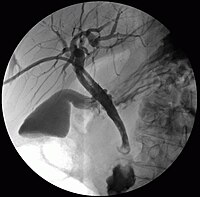
Photo from wikipedia
Percutaneous transhepatic gallbladder drainage (PTGBD) is an important procedure for initial treatment of severe acute cholecystitis (AC) that is contraindicated for early laparoscopic cholecystectomy (LC). We presented our primary experience… Click to show full abstract
Percutaneous transhepatic gallbladder drainage (PTGBD) is an important procedure for initial treatment of severe acute cholecystitis (AC) that is contraindicated for early laparoscopic cholecystectomy (LC). We presented our primary experience on a new approach of cholangiography via PTGBD (PTGBD-C) for preoperative delineation of biliary anatomy. A retrospective analysis was conducted on 93 patients who received PTGBD followed by LC for AC, with allocation into 2 groups that were PTGBD with (PTGBD-C group, 32 patients) or without (PTGBD-N group, 61 patients) cholangiography. All the clinical data, including demographics, cholangiography findings, operations, and complications, were collected and analyzed. Cholangiography was attempted in 32 patients with a success of 31 cases, and the most common complication was transient fever in 3 patients. PTGBD-C group of patients showed significantly less operation time (83.2 ± 22.32 vs. 106.5 ± 40.25 min, P = 0.041) and conversion rate (0 vs. 2). There was no statistical difference in terms of postoperative hospitalization and complications. PTGBD-C is a feasible and safe procedure for severe AC patients with delayed LC. It has advantages of direct cholangiography, being easy to perform and cost-effective, thus should be considered for clinical usage.
Journal Title: Surgical Endoscopy
Year Published: 2021
Link to full text (if available)
Share on Social Media: Sign Up to like & get
recommendations!